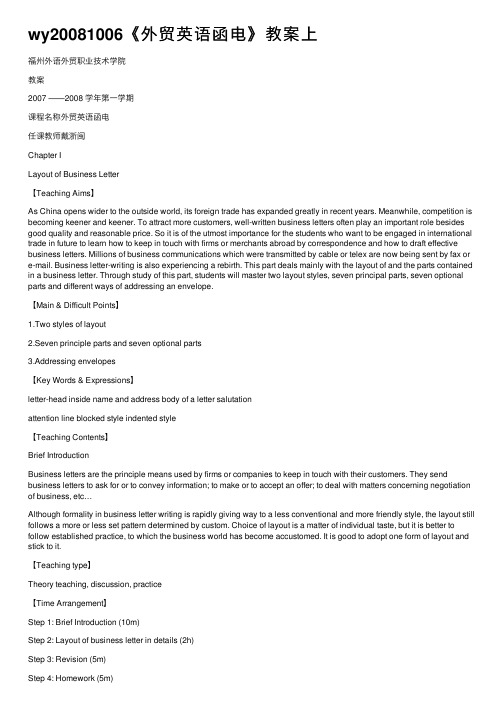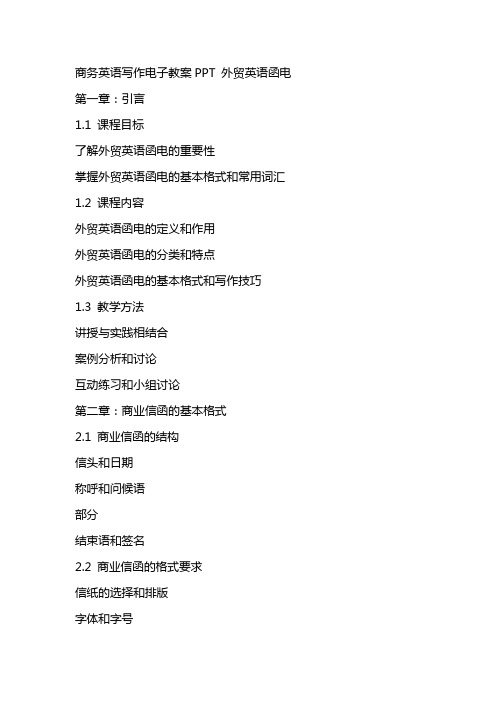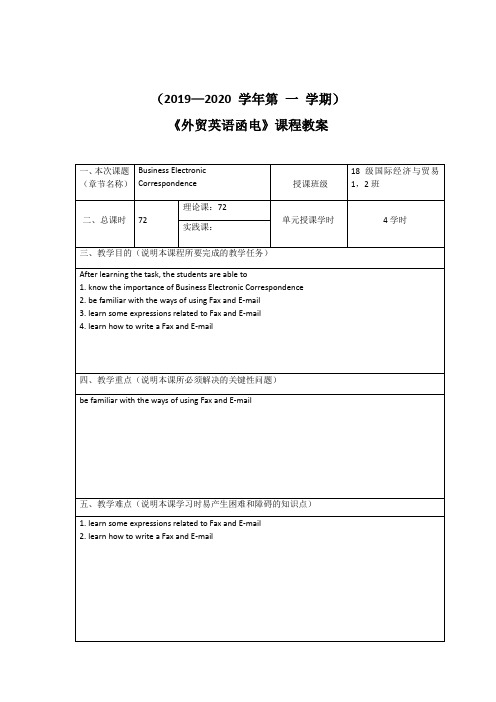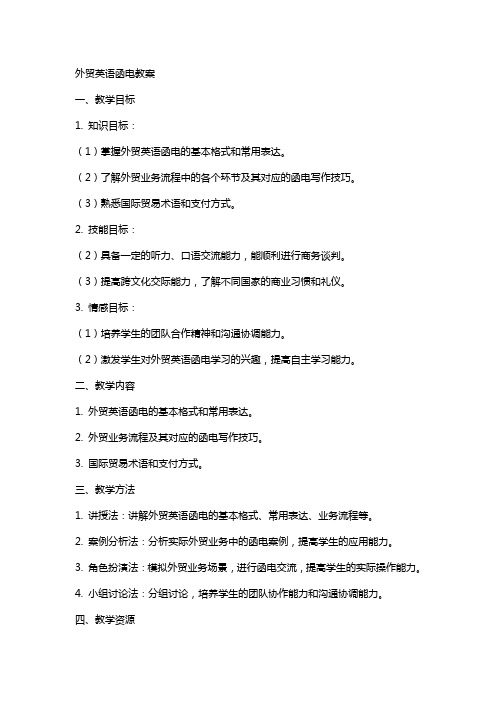尹昕外贸英语函电说课稿
wy20081006《外贸英语函电》教案上

wy20081006《外贸英语函电》教案上福州外语外贸职业技术学院教案2007 ——2008 学年第⼀学期课程名称外贸英语函电任课教师戴浙闽Chapter ILayout of Business Letter【Teaching Aims】As China opens wider to the outside world, its foreign trade has expanded greatly in recent years. Meanwhile, competition is becoming keener and keener. To attract more customers, well-written business letters often play an important role besides good quality and reasonable price. So it is of the utmost importance for the students who want to be engaged in international trade in future to learn how to keep in touch with firms or merchants abroad by correspondence and how to draft effective business letters. Millions of business communications which were transmitted by cable or telex are now being sent by fax or e-mail. Business letter-writing is also experiencing a rebirth. This part deals mainly with the layout of and the parts contained in a business letter. Through study of this part, students will master two layout styles, seven principal parts, seven optional parts and different ways of addressing an envelope.【Main & Difficult Points】1.Two styles of layout2.Seven principle parts and seven optional parts3.Addressing envelopes【Key Words & Expressions】letter-head inside name and address body of a letter salutationattention line blocked style indented style【Teaching Contents】Brief IntroductionBusiness letters are the principle means used by firms or companies to keep in touch with their customers. They send business letters to ask for or to convey information; to make or to accept an offer; to deal with matters concerning negotiation of business, etc…Although formality in business letter writing is rapidly giving way to a less conventional and more friendly style, the layout still follows a more or less set pattern determined by custom. Choice of layout is a matter of individual taste, but it is better to follow established practice, to which the business world has become accustomed. It is good to adopt one form of layout and stick to it.【Teaching type】Theory teaching, discussion, practice【Time Arrangement】Step 1: Brief Introduction (10m)Step 2: Layout of business letter in details (2h)Step 3: Revision (5m)Step 4: Homework (5m)【Teaching Methods】Instruction, discussion, practice【Teaching Resources】Multi-media【Teaching Procedures】Step 1. Layout of business letter in detailsⅠ、The writing of business letter 商业书信的撰写商业书信的特点:1、完整2、具体3、清楚4、简洁5、礼貌6、体谅7、正确Ⅱ、Styles of layout1.Indented Form / Style 缩头式,缩⾏式2.Blocked Style 齐头,平头式3.Modified Style / Semi-Indented Style 混合式→ Modified Block with Indented Paragraphs 段落缩头式Modified Block with Blocked Paragraphs 段落齐头式Ⅲ、The Structure of a Business Letter(Ⅰ) Seven Main / Principle Parts 七个主要部分1.The Heading or Letter-head 信头→公司名称和地址(name and address of the company)电话、电传、传真号码、电报挂号(telegraphic address)、e-mail 2.The Date / Date Line ⽇期1)年份应完全写出:eg. 19982)⽉份应⽤英⽂,不⽤数字3)⽉份名称可缩写:Aug. , Oct.4)24th March, 2007 (Br. Style)March 24, 2007 ( AmE. Style)3.The Inside Name and Address 封内名称,地址(1)Generally, the inside name and address in an English business letter should includethe following:1)the name of the firm or company addressed to2) number and street 门牌号码和街名3)name of city, state or country and its postal code 所在城市、州、县名及邮政编码P.O. Box 信箱4)name of country(2)C/O: care of 转交(3)⾏名前(以⼈名为⾏名)冠以“Messrs‖,表客⽓4.The Salutation 称呼商业函件多⽤Dear Sirs, 不能单独⽤Sirs.公事函件⽤Dear Sir. 半公半私⽤Dear Mr.美国⼈常⽤Gentlemen, 后⽤冒号Dear Sirs 后⽤逗号5.The Body1) The Opening Sentences 开头语2)The Body of the Letter 信的正⽂3)The Closing Sentences 结尾语a. ⽤分词短语开头A waiting your good news, we are,b. ⽤完整句⼦开头We await your good news.6.The Complimentary Close 结束语,结尾敬语1)The complimentary close is a polite way of bringing a letter to a close. It keeps in tone with the salutation. The most common used sets of salutation andcomplimentary close are:Formal : Dear Sirs, …. Y ours faithfullyGentlemen: … Truly yoursLess formal: Dear Mr. Henry: …Y ours sincerelyDear Ms. Smith: … Y ours cordially2)Formal 顺序V ery sincerely yours,Y ours very sincerely,Y ours sincerelySincerely yoursSincerely,7.The Signature 签名The name of the firm that the writer represents should be written in capitals below the complimentary close, followed by thesignature of the manager. To sign with a rubber stamp shows discourtesy.商号名称⽤⼤写,再由负责⼈签名,⽤图章有⽋礼貌。
20130827 尹昕的外贸英语函电说课整体设计

外语系《外贸英语函电》课程实践项目实施方案 本课程开设实训项目如下:1. 商务函电撰写实训;2. 世格外贸实务软件模拟实训;3. 网上模拟外贸操作实训共34课时。 实训目标 通过本课程的学习,学生掌握国际贸易知识,具备用商务(函电)英语进行书面沟通 、缮制外贸单据、拟定合同的技能,具有良好的职业素质和较强的可持续发展能力。 具体目标如下: 1.掌握英文商务书信的基本格式和常用词汇、句型,具备英文商业书信 的阅读与书写能力。2.熟悉单证的含义、作用、种类内容和相关知识即技巧。3.掌握 信用证、商业发票、装箱单、出口托运单、原产地证书、出口货物报检单、出口货物 报关单、投保单、海运提单、装船通知、受益人证明、汇票等出口单证的基本内容。
教师提出工作任务 ?
教师分析设计 学习任务 教师分析设计 实训任务
教师引导完成 学习任务
教师引导完成 实训任务 学生模拟完成 实训任务
学生设计完成 学习任务
体 现 了 教 学 做 一 体 的 教 学 模 式 。
验收评价
四、学情与学法分析:
(1)外语系女生较多(占90%左右),男生较少,课堂气氛不
活跃。
成果提交,教师点评(3分钟)
单元小结、布置作业 (3分钟)
教学单元设计——教学方法
结构式教学法四步曲
观看教师示范 模仿范例 自我强化训练
形成系统的 知识结构
观
模
Ⅱ初步模仿
练
Ⅲ强化训练
评
Ⅰ示范阶段
Ⅳ老师评价
情景教学与角色扮演法 任务驱动与实际操练法
教学单元设计
☆教学内容:
1. 2. 3. 4. 5. 询盘的概念和要求 一般询盘和具体询盘的运用 询盘基本术语和句型 询盘信函的翻译和写作学习 学生根据要求进行询盘信函写作
商务英语写作电子教案外贸英语函电

商务英语写作电子教案PPT 外贸英语函电第一章:引言1.1 课程目标了解外贸英语函电的重要性掌握外贸英语函电的基本格式和常用词汇1.2 课程内容外贸英语函电的定义和作用外贸英语函电的分类和特点外贸英语函电的基本格式和写作技巧1.3 教学方法讲授与实践相结合案例分析和讨论互动练习和小组讨论第二章:商业信函的基本格式2.1 商业信函的结构信头和日期称呼和问候语部分结束语和签名2.2 商业信函的格式要求信纸的选择和排版字体和字号段落和行间距2.3 实例分析商业邀请函商业感谢信商业投诉信第三章:商业信函的写作技巧3.1 明确目的和对象了解收信人的需求和兴趣突出重点和简洁明了3.2 使用恰当的语气和语言正式和礼貌的语言3.3 逻辑结构和连贯性清晰的段落和主题句适当的过渡词和连接词第四章:商业电子邮件的写作技巧4.1 电子邮件的格式和结构电子邮件的和称呼部分和附件4.2 电子邮件的写作技巧简洁明了的表达适当的语气和语言注意电子邮件的语气和风格4.3 实例分析商业询问电子邮件商业报价电子邮件商业确认电子邮件第五章:外贸英语函电的常用词汇和表达5.1 外贸术语和缩写EXW、FOB、CIF等Incoterms 20245.2 常用表达和短语询问和答复报价和议价付款和交货5.3 行业特定词汇和表达进出口货物运输保险和风险教学时间安排:每章内容的教学时间为2课时,共10课时。
每个章节的教学时间可以根据实际情况进行调整。
教学评估:每个章节结束后进行小组讨论和案例分析。
期末进行综合测试,包括选择题、填空题和写作题。
教学资源:PPT课件和教学资料案例分析和实例参考书籍和在线资源第六章:建立业务关系6.1 背景和目的分析建立业务关系的重要性理解建立业务关系的目的和过程6.2 建立业务关系的步骤查找潜在客户和市场调研初步接触和发送介绍信后续跟进和建立互信关系6.3 实例分析建立业务关系的介绍信跟进邮件和电话沟通达成合作的商务协议第七章:商业询盘与答复7.1 商业询盘的类型和内容了解商业询盘的种类和目的掌握商业询盘的主要内容和要素7.2 商业答复的写作技巧明确答复的格式和结构突出产品特点和优势注意事项和常见错误7.3 实例分析商业询盘的样本商业答复的样本询盘与答复的互动练习第八章:商业报价与议价8.1 报价单的组成和格式理解报价单的构成和要素掌握报价单的制作和排版8.2 报价策略和技巧分析市场需求和竞争状况制定合理的价格策略议价技巧和应对策略8.3 实例分析报价单的样本报价议价的邮件和电话沟通达成价格协议的商务谈判第九章:商业付款与交货9.1 付款方式的种类和选择了解国际贸易中的付款方式掌握信用证、TT、D/P等付款方式的优缺点9.2 交货方式和时间分析不同的交货方式和优缺点确定交货时间和地点9.3 实例分析付款方式的确认邮件交货方式和时间的协议货物运输和跟踪第十章:商业投诉与解决10.1 商业投诉的原因和类型分析商业投诉的常见原因和类型理解投诉的重要性和影响10.2 投诉处理的步骤和技巧掌握投诉处理的流程和关键环节运用有效的沟通技巧和解决方案10.3 实例分析商业投诉的信件和邮件投诉处理的回复和解决方案预防和改进措施的制定教学时间安排:每章内容的教学时间为2课时,共10课时。
《外贸英语函电》P1T2教案

2. be familiar with the ways of using Fax and E-mail
3. learn some expressions related to Fax and E-mail
The aim of letter is to secure the interest of the reader and his cooperation.
There are certain essential qualities of business letters, which can be summed as in the three C’s: Clearness, Conciseness and Courtesy.
Complimentary Close
结束语是一种客套用语,它应与前面的称呼相呼应,后面加逗号。如:Yours faithfully, or Faithfully yours, Truly yours, or Yours truly, Yours sincerely or Sincerely yours。
4. learn how to write a Fax and E-mail
四、教学重点(说明本课所必须解决的关键性问题)
be familiar with the ways of using Fax and E-mail
五、教学难点(说明本课学习时易产生困难和障碍的知识点)
1. learn some expressions related to Fax and E-mail
2. learn how to write a Fax and E-mail
商务英语外贸英语函电写作 - 教案

教案商务英语外贸英语函电写作教案1引言1.1教学背景与重要性1.1.1国际贸易中英语函电的广泛应用1.1.2英语函电写作在商务沟通中的核心作用1.1.3掌握外贸英语函电写作对职业发展的积极影响1.1.4教学目标:提升学生的商务英语写作能力与沟通技巧2知识点讲解2.1商务英语函电的基本结构2.1.1传统的五段式结构:开场、背景、主体、结尾、礼貌结束语2.1.2商务函电的格式规范:字体、字号、行距等2.1.3常用商务术语与表达方式2.1.4如何根据不同情境调整函电结构和内容3教学内容3.1函电写作技巧3.1.2如何在函电中有效表达感谢与道歉3.1.4如何在函电中展示专业性和礼貌3.2案例分析与练习3.2.1分析经典商务英语函电案例3.2.3小组讨论与反馈:提升写作技巧3.2.4教师点评与指导:针对学生写作中的常见问题进行讲解与指导3.3实际应用与拓展3.3.1模拟商务情境,实际应用函电写作技巧3.3.2探讨跨文化商务沟通中的注意事项3.3.3如何利用现代通讯工具提升商务函电的效果3.3.4拓展阅读:推荐相关商务英语书籍与资源4教学目标4.1提升商务英语写作能力4.1.1理解并掌握商务英语函电的基本结构与格式4.1.2学会使用专业术语和表达方式4.1.4提高函电写作的清晰度、准确性和说服力4.2增强商务沟通技巧4.2.1掌握商务沟通的基本原则和策略4.2.2学会根据不同情境调整沟通方式和内容4.2.3提高跨文化商务沟通的能力4.2.4增强在商务活动中的自信心和应对能力4.3培养批判性思维和解决问题的能力4.3.1通过案例分析,培养批判性思维能力4.3.2学会分析问题、制定解决方案4.3.3提高在商务活动中遇到问题时,独立思考和解决的能力4.3.4增强团队合作和沟通协调的能力5教学难点与重点5.1商务英语函电的结构与格式5.1.1难点:掌握五段式结构和格式规范5.1.2重点:如何根据不同情境调整函电结构和内容5.1.3难点:使用专业术语和表达方式5.1.4重点:提高函电写作的清晰度、准确性和说服力5.2商务沟通技巧5.2.1难点:掌握商务沟通的基本原则和策略5.2.2重点:提高跨文化商务沟通的能力5.2.3难点:在商务活动中应对突发问题的能力5.2.4重点:增强在商务活动中的自信心和应对能力5.3批判性思维和解决问题的能力5.3.1难点:通过案例分析,培养批判性思维能力5.3.2重点:学会分析问题、制定解决方案5.3.3难点:提高在商务活动中独立思考和解决的能力5.3.4重点:增强团队合作和沟通协调的能力6教具与学具准备6.1教具准备6.1.1PPT课件:包含商务英语函电的案例、知识点讲解等6.1.2商务英语函电教材:供学生参考和自学6.1.4纸质材料:打印商务英语函电案例和练习题6.2学具准备6.2.2笔和纸:用于记录笔记和练习写作6.2.3商务英语词典:帮助理解专业术语和表达方式6.2.4商务英语函电范文:供学生参考和学习7教学过程7.1导入与热身7.1.1引入商务英语函电的话题,激发学生的兴趣7.1.2通过小组讨论,让学生分享对商务英语函电的理解和经验7.1.3引导学生思考商务英语函电在商务活动中的重要性7.1.4提出本节课的教学目标和内容7.2知识讲解与案例分析7.2.1详细讲解商务英语函电的基本结构和格式规范7.2.2通过案例分析,让学生了解不同类型的商务函电7.2.3讲解商务英语函电中的常用术语和表达方式7.2.4分析商务沟通中的难点和重点7.3练习与讨论7.3.1分组进行商务英语函电写作练习7.3.2小组内部互相批改和讨论,提出改进意见7.3.3教师挑选部分作品进行点评和指导7.3.4针对学生写作中的常见问题进行讲解和指导7.4.2鼓励学生提出疑问和反馈,进行解答和讨论7.4.3分享商务英语函电写作的技巧和经验7.4.4布置课后作业,巩固所学知识8板书设计8.1知识框架8.1.1商务英语函电的基本结构与格式8.1.2商务英语函电的常用术语和表达方式8.1.3商务沟通的基本原则和策略8.1.4批判性思维和解决问题的能力8.2案例分析8.2.1商务英语函电案例展示8.2.2案例分析中的关键点和技巧8.2.3学生案例分析成果展示8.2.4教师点评和指导8.3练习与讨论8.3.1商务英语函电写作练习题目8.3.2学生练习成果展示8.3.3小组讨论和互相批改8.3.4教师点评和指导9作业设计9.1商务英语函电写作练习9.1.2使用专业术语和表达方式9.1.3提高函电写作的清晰度、准确性和说服力9.1.4课后互相批改和讨论9.2案例分析报告9.2.1分析商务英语函电案例9.2.2提炼关键点和技巧9.2.4分享和讨论9.3批判性思维和解决问题的练习9.3.1分析商务活动中遇到的问题9.3.2制定解决方案9.3.3提高独立思考和解决的能力9.3.4分享和讨论10课后反思及拓展延伸10.1教学反思10.1.1教学过程中的优点和不足10.1.2学生参与度和学习效果10.1.3教学方法和策略的调整10.1.4提高教学质量和效果10.2拓展延伸10.2.1推荐相关商务英语书籍和资源10.2.2鼓励学生参加商务英语实践活动10.2.3提供商务英语函电写作的在线课程和辅导10.2.4建立商务英语学习社群,促进学生交流和合作重点关注环节:1.教学难点与重点:商务英语函电的结构与格式、商务沟通技巧、批判性思维和解决问题的能力。
《外贸英语函电》教案

《外贸英语函电》单元教学设计任课教师: $$$$单元教学设计基本框架第一部分:组织教学(时间:10分钟)因为本单元是该门课程的第一次课,因此本单元两节课中,第一节课我们安排是课程的概述。
通过同学都比较关心的国际贸易现状导出我们的课程教学。
第二部分:学习新内容【步骤一】说明课程教学目的(时间:15分钟)首先向学生呈现一份从网上截获的商机,要求大家仔细阅读后翻译,问学生在处理这样的信函时什么方面存在问题。
引导学生了解《外贸英语函电》课程教学的学习目的。
【步骤二】说明课程教学内容(时间:15分钟)引导学生一起回顾上学期国际贸易实务当中学到的知识,回答问题:一宗出口业务一般可以分成哪几个主要的阶段。
第一阶段:寻找贸易伙伴,建立销售渠道第二阶段:对外进行洽谈第三阶段:合同的履行结合书本的目录介绍本课程授课的内容。
【步骤三】学习新知识1、新知识导入(时间:20分钟)向学生呈现两份不同格式的英语信函,请同学结合书上的内容回答问题,从而导出我们接下来要介绍的内容:信函的格式。
2、新知识的介绍(时间:25分钟)分别介绍书信常见的几种格式和每种格式的特点。
通过范文,分别介绍一封商务信函的结构。
【步骤四】总结(时间:5分钟)我们回顾前面所学的重要知识点:信函的格式、信函的组成部分等。
单元教学设计基本框架第一部分:组织教学和复习上次课主要内容(时间:10分钟)回顾了上堂课的内容,在我们上堂课讲的例文中设计几个典型的错误让学生找出并修改,从而复习上堂课讲到的信函的构成等内容。
第二部分:学习新内容2、写信的原则【步骤一】提出问题(时间:20分钟)向学生展示两份信函:信函1:Dear John,Very many thanks to you, my dear friend, of the splendid present that you have sent me, and I feel deeply moved by this token of your affection. It is a great consolation for me, in my confinement to hospital by illness.I am glad to tell you, I am making rapid progress toward health every day.Looking forward to joining you at school as soon as possible.Yours affectionately,信函2:Dear Mr. Hunter,We hope that everything at your end is fine. We haven’t heard from you for a long time since the war broke out. We hope we could renew the business cooperation as quickly as possible.We confirm with thanks receipt of your first enquiry and look forward to your first order.Best regards,Yours faithfully,Henry让学生通过比较,发现外贸英语信函与一般信函不同点。
外贸英语函电教案

外贸英语函电教案一、教学目标1. 知识目标:(1)掌握外贸英语函电的基本格式和常用表达。
(2)了解外贸业务流程中的各个环节及其对应的函电写作技巧。
(3)熟悉国际贸易术语和支付方式。
2. 技能目标:(2)具备一定的听力、口语交流能力,能顺利进行商务谈判。
(3)提高跨文化交际能力,了解不同国家的商业习惯和礼仪。
3. 情感目标:(1)培养学生的团队合作精神和沟通协调能力。
(2)激发学生对外贸英语函电学习的兴趣,提高自主学习能力。
二、教学内容1. 外贸英语函电的基本格式和常用表达。
2. 外贸业务流程及其对应的函电写作技巧。
3. 国际贸易术语和支付方式。
三、教学方法1. 讲授法:讲解外贸英语函电的基本格式、常用表达、业务流程等。
2. 案例分析法:分析实际外贸业务中的函电案例,提高学生的应用能力。
3. 角色扮演法:模拟外贸业务场景,进行函电交流,提高学生的实际操作能力。
4. 小组讨论法:分组讨论,培养学生的团队协作能力和沟通协调能力。
四、教学资源1. 教材:外贸英语函电教材。
2. 课件:制作精美的PPT课件。
3. 案例资料:实际外贸业务中的函电案例。
4. 网络资源:国际贸易网站、外贸论坛等。
五、教学评价1. 平时成绩:考察学生的课堂表现、作业完成情况、团队协作等。
2. 实践作业:让学生独立完成一份外贸英语函电,检验其掌握程度。
3. 期末考试:设置有关外贸英语函电的试题,测试学生的综合运用能力。
六、教学安排1. 课时:共计32课时,每课时45分钟。
2. 教学计划:课时1-4:介绍外贸英语函电的基本格式和常用表达。
课时5-8:讲解外贸业务流程及其对应的函电写作技巧。
课时9-12:深入学习国际贸易术语和支付方式。
课时13-16:通过案例分析,提高函电写作能力。
课时17-20:进行角色扮演和小组讨论,增强实际操作能力。
课时21-24:复习巩固所学知识,进行实践作业的指导。
课时25-28:进行期末考试的复习和模拟测试。
《外贸英语函电》教案-交易磋商

项目一交易磋商一、教学目标1.了解外贸函电的目的及作用。
2.了解“询盘”相关的基本商务知识、写作要求和内容要点3.分析信例总结并掌握函电格式的构成。
4.了解“发盘”相关的基本商务知识、写作要求和内容要点。
5.了解“还盘”相关的基本商务知识、写作要求和内容要点6.了解“建立业务关系”相关的基本商务知识、写作要求和内容要点。
7.了解“包装”相关的基本商务知识、写作要求和内容要点。
二、课时分配本项目共6个任务,安排12课时。
三、教学重点在本项目中,我们通过我国一家外贸公司与国外公司在业务磋商方面的信件往来,来掌握该项目的基本知识;会用学到的相关格式和内容表达,独立完成该环节的信件书写,并学会相关的词组句子、重要表达、实践知识等。
理解“建立业务关系”函电书写的内容、格式、步骤以及典型的表达。
理解“询盘”函电书写的内容、格式、步骤以及典型的表达,理解“发盘”函电书写的内容、格式、步骤,以及典型的表达, 理解“还盘”函电书写的内容、格式、步骤,以及典型的表达。
四、教学难点熟悉函电写作的7C原则。
掌握“还盘”的信件书写,结合格式、步骤、内容等方面,完成信件书写。
掌握“包装”的信件书写,结合格式、步骤、内容等方面,完成信件书写。
掌握“建立业务关系”的信件书写,结合格式、步骤、内容等方面,完成信件书写。
掌握“发盘”的信件书写,结合格式、步骤、内容等方面,完成信件书写。
掌握“询盘”的信件书写,结合格式、步骤、内容等方面,完成信件书写;五、教学内容任务一建立业务关系任务描述:在该任务中,练习者要从一名外贸公司出口部门业务员的身份出发,以“建立业务关系”为主题,运用下文中所学到的相关格式和内容表达,独立完成一份写给对方公司的信件。
知识储备I. The Purpose and Functions of Business LettersThe purposes of communication are to obtain complete understanding between the parties involved,and elicit the responses required. Generally speaking, the functions of a business letter are to ask for or to convey business information, to make or to accept an offer, to deal with matters concerning various businesses.Usually, there are certain essential requirements for a good business letter, which can be summed up in the Seven Cs, i.e. Completeness,Concreteness,Clearness/Clarity,Conciseness,Courtesy,Consideration, Correctness. These Cs often go hand-in-hand.II. The Basic Parts of Business LettersSee the letter first and find out how many parts are included in this letter:Guangdong Foreign Trade Development Corp.779 East Dongfeng Road,Guangzhou, ChinaCable Address: 5527 GFTDC Telex: 44388 GFTDC CNSeptember 15, 2010H. J. Wilkinson & Co. Ltd.245 Lombart Street,Lagos, NigeriaDear Sirs,We learned the name of your company from the Bank of China, Guangzhou /Guangzhou Branch of Bank of China.We are specialized in exporting the Chinese light industrial products, which enjoy good reputation in the world market for a long time.Enclosed please find a catalogue for your reference, and we look forward to entering into business relationship with you.Anticipate your early reply.Yours Sincerely,Liu MingLiu MingSales Manager of Export DepartmentIn sequential order of completion, a business letter basically consists of the following 13 parts.(7 of the 13 parts are basic and necessary.)(1) Letterhead(信头)As the first and most obvious part of a business letter,the letterhead expresses a company’s personality. It helps to form one’s impression of the writer’s firm. Styles vary considerably, but they all give similar information and include the essential particulars about the writer — name, address, zip-code, telephone number, telegram fax number and e-mail address of the company. It is usually designed and printed in the center or on the left margin at the top of the page. (2) Reference Number(参考号/发文编号)The reference number is generally used as a useful indication for filing and consulting for both sides, so it must be easily seen. It mayinclude a file number, a contract number, an L/C number or the initials of the signer and the typist’s initials. If you find the reference number in the incoming letter you need to take the form as “your ref.” and “our ref.” in your reply. The position of the reference number is often one or two lines below the letterhead.(3) Date(日期)Every letter should be dated. Never send out a letter without a date. If you are giving information, such as shipping or delivery or appointment dates, it is vital that the date should be correct. The position of the date is often one or two lines below the reference number or letterhead (if there is no reference number).September 8, 2007 — American form8th September, 2007 — British form(4) Inside Name and Address(信内地址)It consists of the name and address of the receiver. It appears exactly the same way as on the envelope. Inside name and address are always put at the left margin at least two lines below the date.Ms. Sarah Davis姓名The Sales Manager职务The Space Engineering Co.,Ltd. 公司名830 W. Lauridsen Boulevard 小地址Port Angeles, WA 98363大地址USA国家名(5) Salutation(称呼)The salutation is the polite greeting with which a letter begins. It should be placed two lines below the inside address. There are many forms of salutation in a business letter. The customary greeting in a business letter is “Dear Mr./Mrs./Ms./Miss ...(姓)”,“Dear Sirs”or “Dear Madam or Sir”.(6) Subject Line(事由标题)The subject line is often inserted between the salutation and the body of the letter. The subject line helps to attract attention to the topic of the letter. It is especially useful if two companies have a lot of correspondence with each other on a variety of subjects, as it immediately tells what the letter is about. It is also useful as a guide for filing. It can begin with or without “Re:” or “Subject:”. Sometimes, you can see the subject line is underlined. e.g.Re: Sewing MachinesSubject: Sewing MachinesSewing Machines(7) Body of the Letter(正文)This part contains the actual message of the letter. It should begin two lines below the subject line or two lines below the salutation if there is no subject line. Usually, it is divided into three parts: opening,actual message and closing. The body of the letter should be carefully planned and paragraphed. The opening is to give the reason of writing and often refers to previous correspondence. The actual message is to specify the writer’s concrete purposes, requirements and wishes. The closing is to express thanks and anticipations for future actions or plans. Sometimes the closing may be used to sum up the message and to suggest the writer’s requirements to the receiver.(8) Complimentary Close(结尾敬语/套语)The complimentary close is merely a polite way of bringing a letter to a close. It is usually placed two or four lines below the last line of the body of the letter. There are many different complementary closes that show respect, but it should match the salutation. The most common sets of salutation and the complimentary close are as follows:Yours faithfully,Yours sincerely,(9) Signature(落款签字)The signature is the signed name or mark of the person writing the letter or that of the firm he or she represents. All letters must be signed and a letter should be signed by hand, and in ink. Unsigned letters have no authority and a letter “signed” with a rubber stamp is a form of discourtesy. Usually, the name of the signer is typed below the signature because many handwritten signatures are illegible, and then followed by his or her job title or position. If the writer represents a certain institute, the name of the institute will be printed above the signature.e.g.The Overseas Co., Ltd. institute(Signature)signatureJohn Bellname of the signerGeneral Manager, Sales Department position(10) Reference Notation(经办人代号)Sometimes, the reference notation, which is also understood as identification mark,can also be placed two lines below the typed signature. The reference notation usually shows only the initials of the typist, but it can also be made up of the initials of the person who dictated the letter. The initials of the dictator are usually in capital letters. The two sets are separated by a colon or a slant, such as for Bill Clinton (manager) and Nancy Brown (secretary). The following examples are acceptable forms of the reference notation:BC: nbBC/nb(11) Enclosure Notation(附件)If any documents such as catalogues, price lists, order, copies of fax are sent with a letter, it is necessary to add enclosure notationto remind the receiver. The enclosure notation is usually placed two lines below the signature at the left margin. The marking may be in any of the following ways:Enclosure: 3 copies of ...Encl. 3 cataloguesEnc. 1 invoice Encls: as stated(12) Carbon Copy Notation(抄送)When copies of the letter are sent to others, you need to use the carbon copy notation below any enclosure notation at the left margin. It is used to show that the letter has been sent to someone relevant. The marking may be in any of the following ways, c.c./cc/bcc—blind carbon copy. e.g.c.c. Mr. J. Cooper(13) Postscript(附言/注)A postscript is used to emphasize a point to which the writer wants to draw the reader’s attention. Sometimes, the postscript can be added by some executives in pen and ink for the purpose of adding a personal touch to their typewritten letter. The marking word of postscript is P.S. and should be placed at least two lines below any other notation and flushed with the left margin.Of all the 13 parts, seven are standard, principal and necessary. The seven parts include the letterhead, the inside name and address,the date, the salutation, the body of the letter, the complimentary close and the signature. The others are optional parts which may be unnecessary for some letters and chosen as the writer wishes. Some letters may contain one or more of the optional parts, depending on the different situation of each writing requirement.注: The Basic Layout of Business Letters1. Letterhead(信头)*2. Reference Number(参考号/发文编号)3. Date(日期)*4. Inside Name and Address(信内地址)*5. Salutation(称呼)*6. Subject Line(事由标题)7. Body of the Letter(正文)*8. Complimentary Close(结尾敬语/套语) *9. Signature(落款签字)*10. Reference Notation(经办人代号)11. Enclosure Notation(附件)12. Carbon Copy Notation(抄送)13. Postscript(附言/注)注:带“*”号为信件必备部分。
- 1、下载文档前请自行甄别文档内容的完整性,平台不提供额外的编辑、内容补充、找答案等附加服务。
- 2、"仅部分预览"的文档,不可在线预览部分如存在完整性等问题,可反馈申请退款(可完整预览的文档不适用该条件!)。
- 3、如文档侵犯您的权益,请联系客服反馈,我们会尽快为您处理(人工客服工作时间:9:00-18:30)。
《外贸英语函电》说课稿
各位专家,教授,各位领导,大家下午好,我是镇江高专外语系的尹昕。
下面,请允许我代表教研室,从课程设置、课程设计、课程实施以及单元设计等几个方面对《外贸英语函电》这门课程做简单的介绍说明。
《外贸英文函电》在我校“四平台八模块”高职课程体系中属于职业能力培养平台的专业核心能力课程模块。
该课程在我系应用英语专业二年级第一学期开设,共64学时,4学分。
《外贸英语函电》课程的开设顺应了我国对外贸易迅速发展,经贸英语专业人才需求急剧增加的历史潮流,在学校“立足就业,着眼发展”的办学方针指导下,本课程教学内容总是服务于外经贸行业要求,直接与外贸行业接轨,体现该行业最新特色,并且随着时代的变化而变化。
可以对应的岗位包括外贸业务员,外贸助理,单证员,跟单员,涉外文员。
该课程在多年的发展过程中具有强大生命力,对提升学生综合素质,增强职业竞争力,服务区域经济有着非常重要的作用。
《外贸英文函电》融合国际贸易知识与英语知识、实践与技能操作为一体,是我系应用英语(外贸)专业课程体系中的专业能力核心课。
本课程开设前后衔接得当,其先修课程是:外贸英语听说、外贸英语精读、外贸英语口语、中西文化比较;其后续课程是:国际市场营销、商务谈判、外贸单证实务、国际支付与结算、国际物流实务。
通过本课程的学习,不仅能让学生熟悉外贸业务各环节的知识,而且能训练学生有关外贸业务各环节的英语表达能力,掌握涉外经贸工作中商务信函的写作技巧,运用函电有效地进行外贸业务联络、沟通、磋商、交易,为学生毕业后完成工作任务,提高工作效率奠定坚实基础。
本着高职教育“实用为主,够用为度”的原则,以提升学生职业竞争力为目标,课程秉承高专“能胜岗,能转岗”人才培养理念,确立了知识、能力和素质三大课程目标。
1、知识目标:通过本课程的学习,学生应掌握
英文商务书信的基本格式和基本要求,熟练掌握外贸各环节函电磋商中常用词汇、表达、句型的运用,具备英文商业书信的阅读与写作能力,为从事对外贸易与国际商务工作打下基础。
2、能力目标:学生应了解WTO规则和国际贸易惯例;初步掌握一定的国际贸易业务操作技能;具备较强的团队合作能力和开拓创新能力。
3、素质目标:通过本课程的学习和技能训练,提高学生学习兴趣,培养热情自信的处事态度、诚实守信的优良品质和勇于竞争,乐于协作的职业素养。
根据我校“立足就业,着眼发展”、“能胜岗,能转岗”的高职教育理念,结合外贸行业函电写作要求,《外贸英语函电》的课程设置遵循以下程序:1.调查了解应用英语人才社会需求状况和规格要求; 2.专家研讨,制定课程标准,明确人才培养目标; 3.选取教学内容,设计课堂教学程序。
本课程的教学设计坚持简单、直观、实用、重点突出、操作性强等原则;以外贸岗位工作对职业能力要求为核心设计课程内容,实施“模块(情境)化教学”,根据外贸业务的主要流程和特点把课程内容分为若干模块;以任务驱动、能力训练为抓手设计教学方法;以过程性评价为主线设计考核方案;教学组织上,采用以学生为主体、强化实践能力为根本的教学理念。
《外贸英语函电》的主要内容有外贸书信格式、询价、报盘、还盘、订货、接受、签约、包装、装运、支付、结算、保险、商检、索赔、代理及仲裁等信函写作知识与技能的学习和训练。
设计的教学模式,以
外贸综合职业能力为主线,以外贸职业岗位要求为核心。
符合学生认知规律。
本课程
本课程采用中国商务出版社的王乃彦主编的《外贸英语函电》教材,属专业教材,实用性强,专业性强。
该教材能帮助学生系统地学习和掌握外贸英语函电,提高学生在外贸业务活动中正确
地使用英语和对外进行业务联系能力。
教材内容的编排方面:
增加图示模型,补充配套实操模拟训练内容。
●增加一些与课文内容相关的图示模型,以便
学生更直观的了解所学产品,并就其相关信息进行联想和讨论和归纳,使学生更快的进入到课文。
●每个章节理论知识后增加配套的实操模拟
训练部分,以便教师更好的实施理论与实践相结合的教学策略,培养出更多优秀的外语外贸人才。
5. 单元教学设计
由于我校开设的行业英语课程种类较多,下面我将以对秘书英语中秘书入职培训这教学情境中的第一课How does one become a secretary?进行设计说明及详细讲解课程实施过程中的教学方法。
本课程的传授对象是:文秘专业二年级学生
本课的教学要求是熟悉面试形式和准备面试的要领。
依据涉外文秘岗位的工作要求,将教学内容情境化,旨在突出教学的职业性和实用性。
整个设计共分四个步骤:导入热身、课文解读、模仿对话以及总结与作业。
第一步,导入热身。
教师提前利用教室的座椅提前布置好模拟面试区。
用常用的交际句型和学生进行问候,由此引出教学主题:秘书面试。
接下来联系专业,做简短的背景知识介绍,利用多媒体播放某公司的秘书面试视频,并提醒学生留意视频中面试时的口语表达,观察其举止,仪表及气质等。
同时提出思考问题:诸如:what kind of preparation should one make before a job interview?
What questions do you like to ask if you were an interviewer? And why are they? 组织学生讨论刚刚提出的问题,练习口头表达,为下一步的教学做好铺垫。
第二步,课文解读。
带领学生朗读生词和词组,简单介绍单词的用法以及同、反义词等。
然后以任务驱动法给学生布置几个问题,让学生带着问题进行快速阅读,在学生完成阅读后,回答问题,教师作适当讲解以帮助学生理解。
接着用讲授法,详细分析、讲解课文,将重点放在词汇、短语的用法和长句的理解上。
最后请学生归纳出请学生归纳出秘书面试时常用句型并要求掌握。
第三步:模仿对话。
要求每个学习小组根据板书内容重新组成新的对话,要求台下表演练习,台上汇报竞赛。
在各组进行了角色扮演后并汇报学习成果,对组内的小组合作学习进行小结,老师进行点评,对每小组出现的问题进行强调。
接着老师进一步对重点的词汇,句型进行梳理。
请前面出错的同学再次上台表演,旨在巩固知识,锻炼口语表达,培养学生的互帮互助。
最后,教师请同学集体归纳本次课的教学重难点,以作业的形式进一步拓展。
